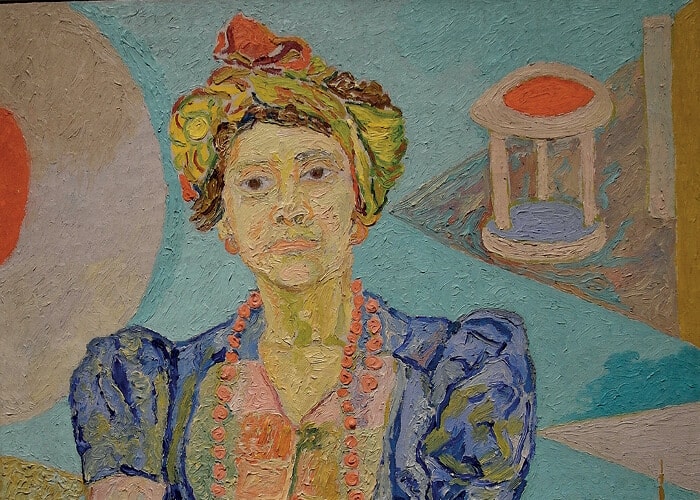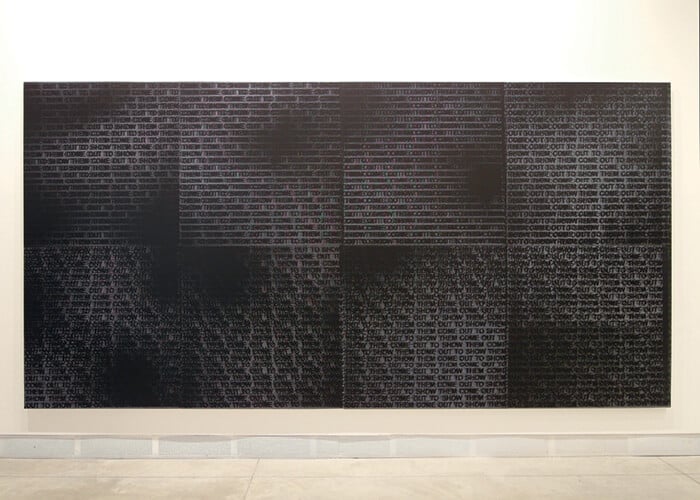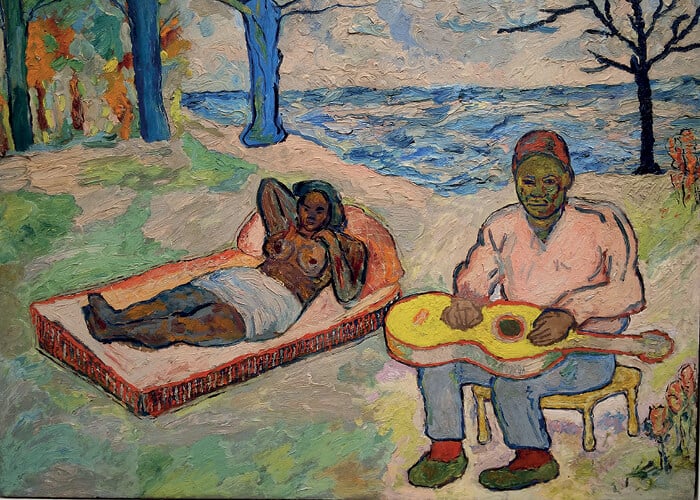In 1940, at age sixteen, James Baldwin knocked on the door of painter Beauford Delaney’s cold-water apartment at 181 Greene Street in Soho. Baldwin was not yet the famous man of letters and activist he is now remembered as, merely a scrawny teen working, as he would later write, a “Dickensian job” after school in a sweatshop on Canal Street. For his part, Delaney was in his mid-30s and Life-magazine famous, which was a big deal in pre-television America. Two years before Baldwin met his creative mentor, Life featured Delaney in an article headlined ‘Negroes: The U.S. Also Has a Minority Problem.’ Delaney, who escaped the dead-end prospects of a Knoxville shoeshine boy after his youthful drawings caught the eye of a local artist, was pictured surrounded by his canvases at the annual outdoor exhibition in Washington Square. He was identified as “one of the most talented Negro painters,” a pejorative summation that this remarkable colourist far exceeded, both in his life and work.
 Beauford Delaney, detail of Edna Porter, 1943. Oil on canvas, 91.5 x 76cm. All images courtesy of Swann Auction Galleries, New York.
Beauford Delaney, detail of Edna Porter, 1943. Oil on canvas, 91.5 x 76cm. All images courtesy of Swann Auction Galleries, New York.
Baldwin’s recall of his first encounter with Delaney, a selection of whose colour-drenched canvases were recently assembled on an exhibition organised by dealer Michael Rosenfeld at the Art Dealers Association of America’s annual fair in March, was detailed and warm. It went like this: one day after work Baldwin made his way to Greene Street, which Delaney would later abstractedly portray in a thickly painted 1950 composition included on Rosenfeld’s showcase at the AADA fair. Baldwin was terrified as he knocked on Delaney’s door. His knock was answered by a “short, round man,” Delaney.
“He had the most extraordinary eyes I’d ever seen,” writes Baldwin in his essay, ‘The Price of the Ticket’ (1985). “When he had completed his instant x-ray of my brain, lungs, liver, heart, bowels and spinal column … he smiledand said, ‘Come in,’ and opened the door.” Baldwin crossed the threshold into a new world. Delaney, who Henry Miller glowingly characterised as an “amazing and unique human being,” became a kind of surrogate father and mentor to Baldwin. Baldwin returned these early life favours in kind. He dedicated his 1965 short story collection, Going to Meet the Man, to Delaney. He also frequently wrote about this extraordinary painter of light and colour, once describing Delaney as “a cross between Brer Rabbit and St. Francis of Assisi.”
Baldwin is not the sole chronicler of Delaney’s life story. There is no shortage of writing about Delaney, especially online. He is a Google search away, as David Foster Wallace once wrote of Roger Federer, “Knock yourself out.” This diffuse online archive tells the story of Delaney’s youthful passage north, from Knoxville to Boston, where he received an academic grounding in painting. It records his immersion in the Harlem Renaissance, his love of jazz and his bonhomie after he moved to New York in 1929. There is writing that fills in the details around his self-imposed exile in Paris from 1953, where he lived until his death. Also fragments related to his complex psychology. “He kept his life in compartments – sex with whites but not with blacks, sex with temporary acquaintances and not with friends, safe politics with most whites, strong race identification with blacks,” his biographer David Leeming wrote in 1998. “His black friends knew little of his white friends; his gay friends knew little of his straight ones.”
 Beauford Delaney, detail of Untitled (Abstraction in Green), 1961. Oil on linen canvas, 41 x 27.5cm.
Beauford Delaney, detail of Untitled (Abstraction in Green), 1961. Oil on linen canvas, 41 x 27.5cm.
And then there is writing that focuses on his creative passage from expressive figuration to luminous abstraction. During his New York period (1929-53), Delaney produced thick, impasto street scenes, studies of jazz-club interiors and numerous colour-rich portraits, including of Baldwin. Delaney however moved on from this observational style when he moved to Paris. Like Norman Lewis, a fellow New Yorker and a key figure amongst black painters, and like the South African Ernest Mancoba, who also found comfort in exile in Paris, Delaney’s mature career is marked by his engagement with pure abstraction. This latter work is now increasingly viewed as amongst his most collectable. Although widely written about, notably by Miller, James Joyce and Georgia O’Keeffe, Baldwin retains a privileged insight.
In 1977, two years before Delaney’s lonely death in a Paris asylum and burial in an unmarked grave, Baldwin wrote an appreciation that effortlessly slots into the sometimes-derided genre of ecstatic art criticism. In thinking more concertedly about what distinguished his “spiritual” father’s work as a painter, Baldwin offered: “If we stand before a Delaney canvas, we are standing, my friends, in the light: and, if in this light, which is both loving and merciless, we are able to confront ourselves, we are liberated into the perception that darkness is not the absence of light, but the negation of it.” A fragment of this quote introduced Rosenfeld’s solo presentation of Delaney’s work inside the Park Avenue Armory.
This recent selling show, one of the highlights of AADA’s fussy showcase of bankable masters (that included Ed Ruscha and Edward Hopper) and overlooked trailblazers (such as Carolee Schneemann), comes at a curious juncture. “After decades of spotty acquisitions, undernourished scholarship and token exhibitions, American museums are rewriting the history of 20th- century art to include black artists in a more visible and meaningful way than ever before, playing historical catch-up at full tilt, followed by collectors who are rushing to find the most significant works before they are out of reach,” reported art critic Randy Kennedy in a November 2015 edition of the New York Times. While a corner is being turned, Kennedy acknowledged that it has been too late for neglected abstract painters like Delaney, Lewis or Alma Thomas to witness during their lifetime.
There is a back-story to this institutional reappraisal. To attribute it to Barack Obama’s presidency is fatuous. There has been decades of cultural activism by artists and curators addressing this neglect, well- known milestones including the founding, in 1969, of the Cinque Gallery by Lewis, Romare Bearden and Ernest Crichlow, and Fred Wilson’s Mining the Museum (1992- 93), a landmark installation inside the Maryland Historical Society, as well as curator Thelma Golden’s 1994 exhibition, ‘Black Male: Representations of Masculinity in Contemporary American Art,’ at the Whitney Museum of American Art. Golden’s exhibition included Wilson’s sculptural installation, Guarded View (1991), a riff on institutional exclusion signalled in the form of four headless black mannequins dressed in the uniforms worn by male security staff at major American museums. But Obama’s presidency is nonetheless significant.
 Glenn Ligon, Come Out #13, 2015. Silkscreen on canvas.
Glenn Ligon, Come Out #13, 2015. Silkscreen on canvas.
Shortly after moving into the White House, the Obamas redecorated the presidential residence with works loaned from the Hirshhorn Museum and Sculpture Garden in Washington. Their selection included two abstract canvases by Alma Thomas as well as Glenn Ligon’s Black Like Me No. 2 (1992), a text-based painting featuring the words, ‘All traces of the Griffin I had beenwere wiped from existence.’ The passage, which is repeated in layers of black ink on a white canvas, is a quote from journalist John Howard Griffin’s nonfiction book Black Like Me (1961) about his journey in the Deep South.
Rosenfeld aside, one of Delaney’s most influential contemporary promoters is Ligon. Last year, shortly before his text- based silkscreen paintings, Come Out No.12-No.15 (2015) were unveiled on ‘All the World’s Futures,’ curator Okwui Enwezor’s sometimes brutal but ultimately engaging keynote exhibition at the 56th Venice Biennale, Ligon curated a group exhibition at Nottingham Contemporary. Titled ‘Encounters and Collisions,’ Ligon’s purposefully crowded show juxtaposed his own work with that of artists who both inspired his practice and offer hints of future directions. Alongside well-known names like Jean-Michel Basquiat, Joseph Beuys, Philip Guston, David Hammons (whose untitled 2000 reimagining of a basketball hoop as baroque sculpture fetched just over $8 million at a 2013 auction) and Adrian Piper (winner of the Golden Lion for best artist at the 2015 Venice Biennale), Ligon’s show included work by Delaney.
“Delaney is a touchstone for me in that he was a queer man, as Baldwin was, negotiating his relationship to the society that he was born in and ultimately choosing exile in Paris in order to ease the bite of American racism,” says Ligon. “As he said, you can’t be an expatriate if you are not considered a citizen. I identify with that search for oneself in the world, and I identify with the sense of not being a full-fledged citizen of one’s country, a country which seems to value black lives as lesser than others.” Delaney is quoted as saying that abstraction is simply “a penetration of something that is more profound in many ways than the rigidity of a form.” I asked Ligon how important, if at all, Delaney is in his own negotiation of abstraction, or what he once described as the “tension between the meaning of the words and the form of the paintings.” His response: “My paintings have always brought text towards abstraction, which has some resonance with Delaney’s sense that abstraction is a deeper exploration of meaning than forms of representation (and I would include text here) can do.”
Ligon’s hyper-visibility is in stark contrast to Delaney. Notwithstanding early success, which, according to Delaney’s biographer, prompted the curious to stand outside his Greene Street apartment in the hope of catching a glimpse of the famous painter, and notwithstanding a major survey exhibition of his work at the Studio Museum in Harlem, in 1978, a year before his death, Delaney is still somewhat of a fringe figure in the American museum, if not the country’s mainstream art history. Why? Writing in a sumptuous catalogue for African American Art: 200 Years, a 2008 selling showcase mounted by Rosenfeld, curator and art advisor Jonathan P. Binstock points out some of the reasons for the long-standing reluctance by critics, curators, scholars and dealers to engage abstraction by black artists of Delaney’s generation. Some of it, he offers, had to do with a historical white bias towards illustration and figuration in black art, which complicated the reception of abstract painting by black artists. The emergence of Black Power politics in the wake of the Civil Rights Movement also created its own set of difficulties. As in South Africa during the struggle against apartheid, engaged artists and critics in the African-American community viewed abstraction as formalist whimsy.
 Beauford Delaney, Untitled (Self-Portrait with Odalisque), c. 1943. Oil on panel, 60 x 80cm.
Beauford Delaney, Untitled (Self-Portrait with Odalisque), c. 1943. Oil on panel, 60 x 80cm. Despite concerted efforts by the Whitney in the late 1960s and early 1970s to showcase work by a range of first-generation African- American abstractionists, “by the early 1970s the art world was still not prepared for the sophistication that black abstract art offered,” curator Kellie Jones, a noted researcher of early abstraction, observed in2006. So, notwithstanding the plaudits of writers like Baldwin, Miller and Joyce, who remarked on Delaney’s “generosity of spirit” and unflappable character, the output of this warm-blooded colourist, who worked contemporaneously with white abstract expressionists during the critical heyday of this painterly movement, was pretty much ignored.
The Museum of Modern Art only acquired its first Delaney, Composition 16 (1954-56), a swirling, colour-field work principally composed in yellow, in 2012, three years after it was shown at Rosenfeld’s midtown gallery. At the time of its 2009 display, New York Times art critic Roberta Smith wrote that it was a “must-have for any museum that wants to expand its definition of abstract expressionism beyond the white men who still dominate it.” For its part, the Whitney owns five Delaneys.They include an untitled 1950 pastel on paper, a study of vegetables and flora marked by its psychedelic force. Its zany intensity prefigures the jagged lines and hipster formalism of South Africans Zander Blom and Jan Henri Booyens by six decades.
For pioneering collectors like comedian Bill Cosby and Detroit-based surgeon Walter O. Evans, the muddled attitudes of white- dominated art institutions made it possible to collect pioneering African-American art like Delaney in relative quiet. Already in 2000, Evans, whose collection also includes paintings by Lewis and numerous letters by Baldwin, told the New York Times that African-American art had “suddenly become in vogue” and that “the value of art is increasing before your eyes.” This may well be, but without a metric it is hard to intuit fact from hype. In 2010, a late- career portrait by Delaney of playwright Jean Genet swaddled in greens fetched a paltry $13,390 at a Christies auction. Last year Untitled (Abstraction in Green) (1961), a lesser example from Delaney’s abstract expressionist period, fetched only $35,000 at Swann Auction Galleries.
There is a subtle undertone of market booster-ism undergirding the story of the recuperation of African-American art. The glacial reclamation of Delaney’s legacy offers just one notable case study. For hispart, Ligon is suspicious of the market- dominated narrative of change. “Historically we have seen black artists who had solo shows at major museums in the United States early in their careers who were never heard from again or ‘rediscovered’ when they were in their 70s or 80s,” says Ligon. “The institutions that first showed them thought that one show was enough. They didn’t invest in their artistic production in the long run, where they did invest in the careers of white male artists.” This has changed a bit, he thinks, but not enough. “When, for example, have you seen two artists of colour have major shows at an institution at the same time? I can’t recall an instance. It is a subtle but tangible signal that the artist of colour is always the ‘special’ exhibition, not part of the normal institutional programme.”
In 1987, nearly a decade after Delaney’s death and a few months before his own, Baldwin was asked by journalist and Miles Davis biographer Quincy Troupe about “the neglect” that seemed to frame Delaney. The question touched a raw nerve. Baldwin’s response was terse: “That’s hard to do because people are still lying about Beauford.” He refused any further comment. Why was it hard? What were people lying about? Baldwin’s abrupt response invites many questions. They include this: when will it be possible to speak about Beauford Delaney and the pleasure of his light-filled paintings without a sense of mourning?
Sean O’Toole is a writer based in Cape Town.
This article was first published as a Positioning Piece in ART AFRICA Magazine, Vol.01, Iss.04, entitled Looking Further North. To read this French translation of this article (translated by the Institut-Francais), click here.



